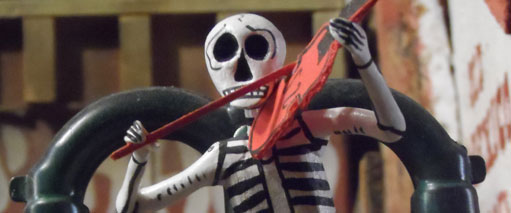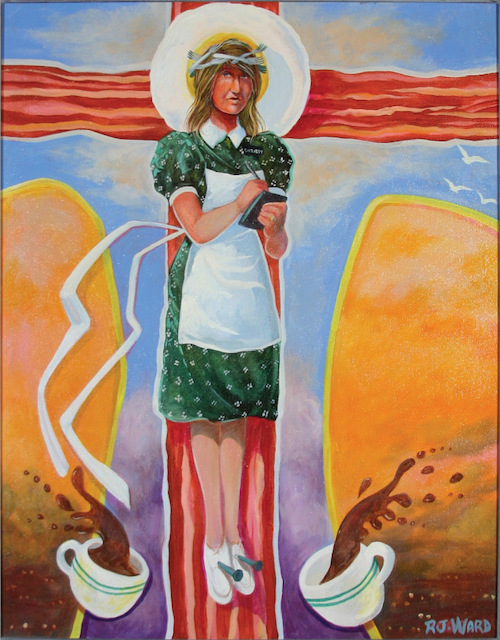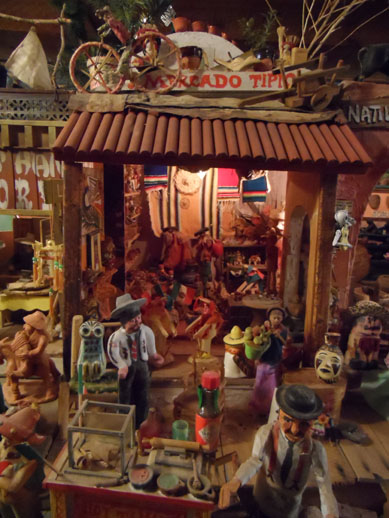From NM-536, the Tinkertown Museum (121 Sandia Crest Rd., Sandia Park) is barely visible behind a row of trees, looking like something you’d find in an elaborate fish tank. Flashes of light reflect off the blue and green glass of a bottle wall, creating impromptu fireworks that leak between the leaves.It took the late Ross Ward, local painter/sculptor/you-name-it, over 40 years to build Tinkertown. The museum is often described in tourist maps and vacation guides with words like “whimsical” or “quirky”—words I try never to use—leading me to expect a bland afternoon of “family fun.” But when I push open the swinging saloon doors at the entrance, leaving the feverish sun to enter a cool and dim corridor, my breath catches in my throat.The entire right side of the hall is a miniature Western town peopled by antique toys and hand-carved figurines. Stores and bars and markets come to life as tiny inhabitants act out a variety of scenes. Every inch of the town seems to sizzle with action.Pushing one of the buttons found at intervals along the length of the town causes a scene to animate. An angry restaurateur clutching a meat cleaver chases a chicken in circles. Drunkards at the saloon raise their mugs.This is not the dusty kitsch nightmare designed to bilk passing travelers that I’ve been expecting. It’s an honest-to-God work of art. In fact, Tinkertown proper is only one room of 22 in the museum. Visitors still have to make their way past a miniature three-ring circus, Otto the one-man band and a 35-foot sailboat permanently docked in the side of a mountain.Along the route appear cryptic quotes painted on wood boards, some attributed to great American thinkers like Mark Twain and E.B. White, and some attributed to Ross himself. “This whole place is like a shrine,” says Carla Ward, “and I kind of think he was just channeling his higher self.” Carla is Ross’ widow. She has agreed to take me through the couple’s former home, which now serves as an unofficial gallery of Ross’ paintings. During his lifetime, Ross only had a few formal exhibits, and I once saw his signature on a mural in a Madrid bar. Other than that and the handful of postcards in the Tinkertown gift shop, his paintings have largely gone unseen by the general public.“He never played that art scene,” Carla says. “You know, I tell people it’s a good thing he didn’t grow up in my family, because they would have sent him to the best art school in the country and probably ruined him.” As Carla takes me past paintings and etchings that cover almost every inch of every wall, I imagine Tinkertown growing up around her over the last 30 years like coral. She points to a piece called “White Shoes.” It depicts a young waitress writing down an order. “Because he traveled so much, painting carnival rides, we would eat in diners. And if the waitress was wearing white shoes, whether she was 16 or 60, he figured that she would be a waitress for life. So here she is, crucified on a Breakfast Special: cross of bacon, crown of forks and the halo of a fried egg.”As we walk through the house, the volume of the collection overwhelms me, and the different paintings start to swim together. I ask, “But did it ever get him down that no one was noticing? Didn’t it bother him that Tinkertown kind of overtook this?”Carla raises an eyebrow. “You know, maybe in the dark nights … but he was just so busy working, and he really didn’t care about what other people thought.”I’m still chewing on this when she shows me a series of nudes—each one a woman posing as a letter of the alphabet. They are photorealistic, uniform and done in pencil … up until the letter L, when they veer off course, changing medium and style drastically from piece to piece. “It starts getting a little wacky,” she says, “because he got Alzheimer’s.”It seems like tasteless irony that an artist so obsessed with the past should be struck with an illness that eats memories. I ask if being in the museum made it worse, and she tells me that if anything, it helped. Ross stayed busy and kept working up to the end in 2002, and being embedded in his masterpiece surrounded him with 40 years’ worth of memories.Carla is obviously a beautiful human being who doesn’t hold a grudge. She’s Buddhist. I, on the other hand, think Ross Ward got a shit deal. The Tinkertown Museum is more than just a pit stop on the Turquoise Trail; it’s a state treasure, and the man deserved at least a hundred parades in his honor.Carla is as saintly as ever. “Well, he was just happy that people liked it.”
Tinkertown Museum
121 Sandia Crest Rd., Sandia Park
Open daily from 9am to 6pm
281-5233,
tinkertown.comTickets: $3.50 general, $3 “geezers,” $1 children, free for children under 4













